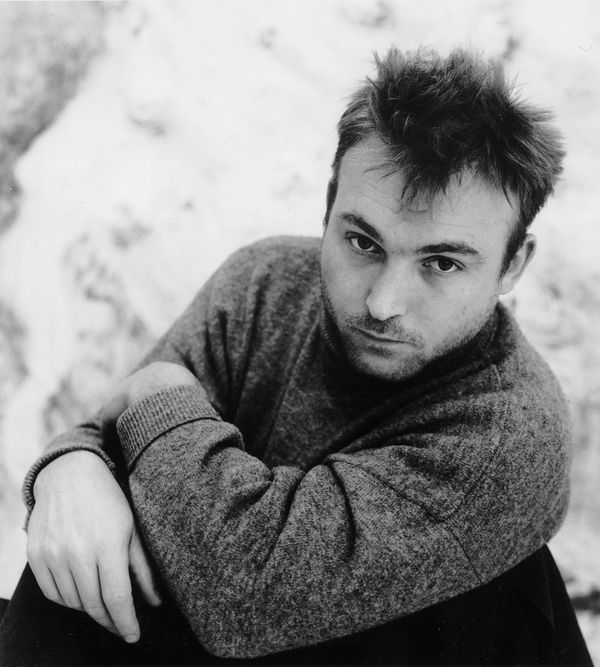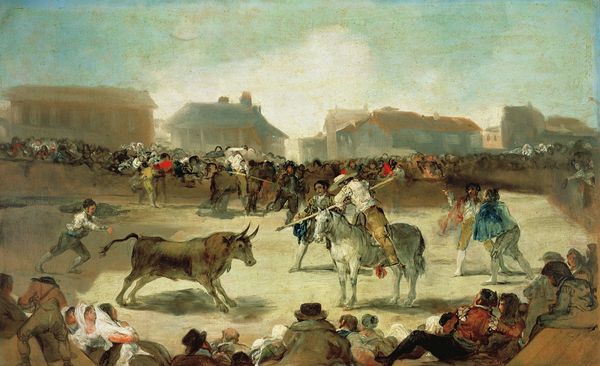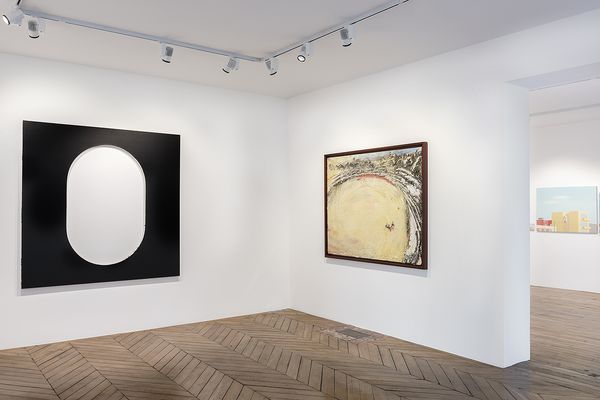Miquel Barceló Muletero, 1990
Plunging the viewer into the midst of the arena, Miquel Barceló's Muletero is one of the artist's highly-celebrated bullfight pictures, painted in 1990. Across more than a metre and a half, the surface of the picture is heaped with incident, impasto and mixed media, spilling from the wall into the viewer's world. Despite this, the yellow sand of the arena appears as the eye of the storm, a void within the vortex of the walls and audience, a zone of immense clarity where the traces of action are visible, and the focus is upon the figure of the torero, the charging bull, and the red flash of the muleta, the cape used to attract and tease the bull during the corrida. At this particular moment, the torero attempts to control the bull, taunting it with the red cape, providing a target and deftly avoiding collision. The closer the margin between them, the greater the effect — as appears to be the case in Muletero, where the bull and the man are shown almost clutched together, only the red of the material separating them, the calligraphic brushstrokes of black almost meeting across it.
[In the late 1980s], a new luminosity came to dominate Barceló's paintings.
Chris Felver, Miquel Barceló, Madrid, 1989, photo © Chris Felver / Bridgeman Images
Barceló is an incredibly erudite artist; during the 1980s, many of his works took the form of dialogues with the weighty burden of Western artistic culture. However, in 1988, seeking an escape from the glut of culture and information that was appearing in his works, Barceló travelled to Africa, where he has maintained a home ever since. There, he was able to flush out superfluity, focusing on the essential in his pictures as in life itself. A new luminosity came to dominate his paintings, and this is clearly in evidence in Muletero. Here, the sand, with its subtle swirl and occasional bruises of other colours, hinting perhaps at earlier spilt blood, echoes the deserts of Africa that had so inspired him. The sheer clarity of this picture, with its focus on the tiny knot of action around the muletero himself, reflects the new path that Barceló had discovered.
Detail of Muletero, depicting the painting's primary figures in near collision within the ring
The theme of the bullfight, so engrained in Spanish culture and the Spanish artistic tradition, affords the viewer a 'before and after' view of the impact of Africa on Barceló's paintings. Earlier in 1988, Barceló had also been commissioned to create a poster for a bullfight in Nimes, France. Two years later, after his African epiphany, he returned to the theme in a string of paintings that included Muletero. Taking the theme of the corrida, Barceló was joining the long line of artists who have treated the subject, for instance Salvador Dalí, André Masson, Pablo Picasso, Francis Bacon and, of course, Francisco José de Goya y Lucientes, whose Tauromaquia is revered to this day.
Francisco Goya A Village Bullfight, 18th Century, oil on canvas, Real Academia de Bellas Artes de San Fernando, Madrid © Image: Bridgeman Images
More recently in 2011, Barceló was once again commissioned for a poster promoting bullfights — in this case, the final one to be held in Barcelona before they were banned in Catalonia. Bullfights continue to arouse great emotions, with huge support from aficionados seeing them enshrined within the cultural and even political firmament in Spain. They also provoke contrastingly strong criticism, for instance in Barcelona, where they have been outlawed. There remains strong support for the corrida in Spain and southern France, with its combination of ritual, elegance and bravery — as well as the visceral risk of gore.
It is that notion of public performance, of success or failure being played out on a grand stage, that makes the bullfight such an apt metaphor for the artistic process for Barceló, and other artists over the centuries. Like the Muletero himself, the artist is out in the arena, observed by a fickle public, facing glory or disaster with every moment. Life balances on an edge, making this an extreme form of entertainment. "As in bullfighting, I believe, one doesn't paint with ideas," Barceló was quoted for a Barcelona exhibition catalogue in 1998. "The painting happens outside ideas, in contradiction to ideas even, generating ideas. That is why such silent art forms spawn so many words."
For Barceló, even the process of creating his bullfight paintings was linked to its subject matter, existing in a perfect, poetic parallel. After all, as he explained, "I put myself in the middle of the picture, making turns, with the same movements as a bullfighter. The sand in the ring is full of footmarks and becomes the setting in which to paint. The arena takes up the whole scene, almost leaving out the crowd from the picture. The painting is overfull."
Miquel Barceló Muletero, 1990 (right) as seen in Phillips' Paris gallery among a selection of highlights from our upcoming 20th Century & Contemporary Art Evening Sale
Having had his revelatory time in Africa, Barceló was granted a different perspective on life, its value and its ephemeral nature. These he has brought to the subject of the bullfight in Muletero. In capturing this fleeting moment of dance and danger in the arena, Barceló has also allowed the bullfight to overcome its performative limitations. After all, when the bout has ended, only its memories remain; the tracks in the sand that delineate the history of the encounter are raked over, the blood shifted, and the next act begins — a tabula rasa, or fresh canvas. In Muletero, the traces of the artist, unlike those of the torero, are enshrined in paint, given a palpable sense of presence through the impasto and mixed media of the surface, which bulges out, spilling into the viewer's realm. Ernest Hemingway wrote of this process in Death in the Afternoon, revealing the poetry at the heart of this process: "It is an art that deals with death, and death wipes it out.' Discussing this paradox, Hemingway continued in terms that are echoed — and transcended — by Muletero:
"Suppose a painter's canvases disappeared with him and a writer's books were automatically destroyed at his death and only existed in the memory of those that had read them. That is what happens in bullfighting. The art, the method, the improvements of doing, the discoveries remain; but the individual, whose doing of them made them, who was the touchstone, the original, disappears."
— Ernest Hemingway, Death in the Afternoon, London, 1958




